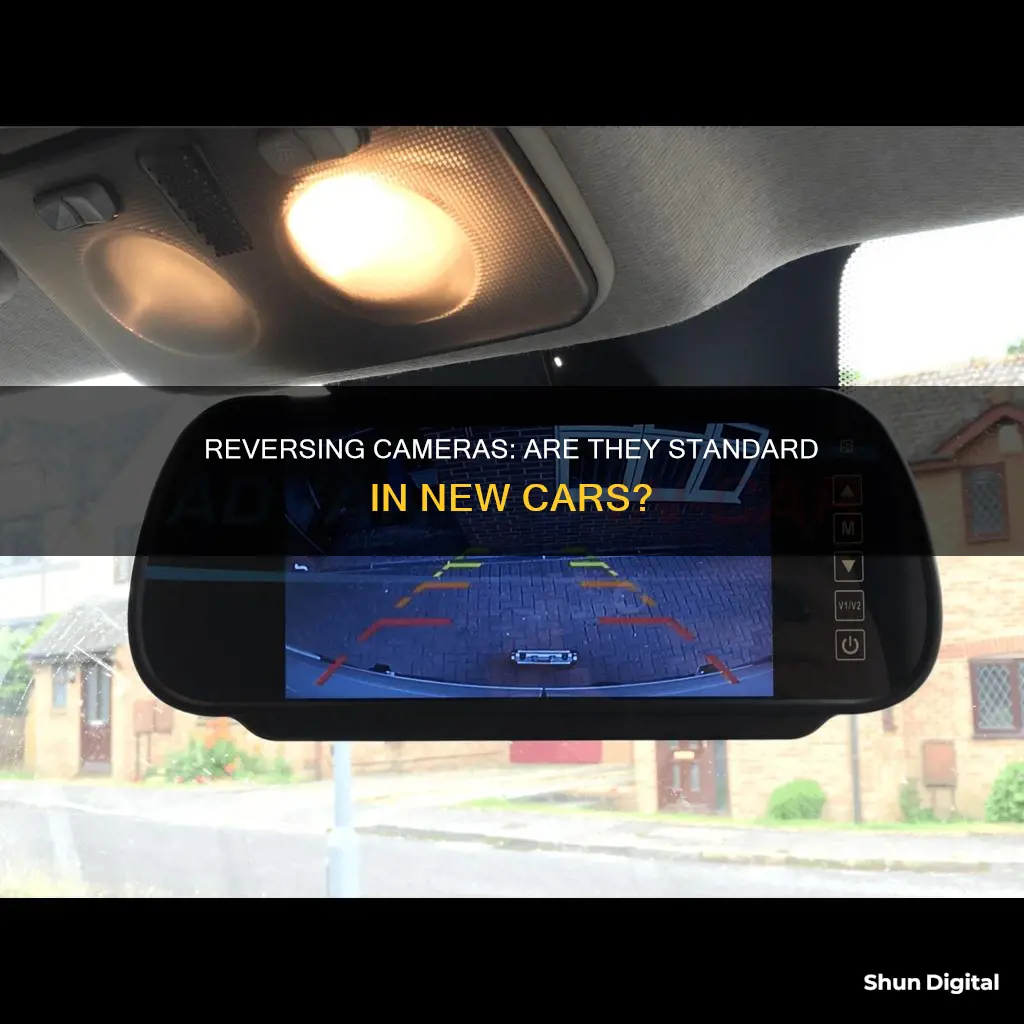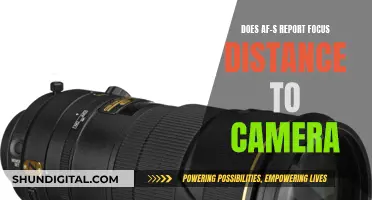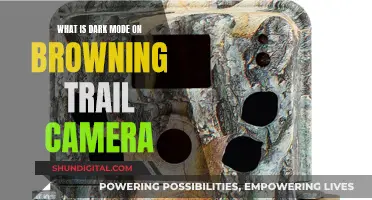
Reversing cameras, also called backup cameras or rear-view cameras, are now a common feature in modern cars. These cameras are attached to the rear of a vehicle and activated when the car is put into reverse, providing a live feed of the space behind the car to help with parking and manoeuvring. While not all cars have reversing cameras, they have been mandatory in new vehicles sold in the United States since 2018 and will be required in all new cars in Australia from 2025. This technology is designed to improve road safety, particularly by reducing the number of accidents involving vulnerable road users, such as children, when reversing.
| Characteristics | Values |
|---|---|
| Countries with reversing camera regulations | US, Canada, Australia |
| Year of US reversing camera regulation | 2018 |
| Year of Australia reversing camera regulation | 2025 |
| Vehicles exempt from US reversing camera regulation | Vehicles weighing more than 10,000 pounds |
| Vehicles exempt from Australia reversing camera regulation | N/A |
| Advantages of reversing cameras | Increased safety, easier parking, better visibility |
| Disadvantages of reversing cameras | Poor image quality, wireless interference, malfunction |
What You'll Learn
- Reversing cameras are now mandatory in new vehicles in the US, Canada, and Australia
- Backup cameras improve safety by reducing blind spots and preventing accidents
- Rearview cameras can be attached to the rear of a vehicle or installed via a number plate bracket
- Reversing cameras can be wired or wireless
- Aftermarket reversing cameras are affordable and easy to install

Reversing cameras are now mandatory in new vehicles in the US, Canada, and Australia
Reversing cameras are now mandatory in all new vehicles sold in the US, Canada, and Australia. In the US, the Cameron Gulbransen Kids Transportation Safety Act of 2007 required the Department of Transportation to issue backup-collision-safety regulations within three years and mandate full compliance within four years. Following this, in March 2014, the National Highway Traffic Safety Administration announced that all automobiles sold in the US, manufactured after May 2018, must include backup cameras. Transport Canada issued a similar mandate, which came into effect at the same time.
In Australia, reversing cameras and rear motion sensors will be mandatory in all new vehicles entering the market from November 1, 2025. This includes all vehicle types, from passenger cars to SUVs and light and heavy commercial vehicles. The Albanese federal government announced these changes to the Australian Design Rules (ADRs), which now include the newly developed 'ADR 108/00 - Reversing Technologies'. This mandate is expected to save "13 lives and avoid 140 severe and 62 minor injuries over the next 45 years", and inject $80.6 million into the economy.
Reversing cameras, also known as backup or rear-view cameras, are designed to aid in reversing and reduce the rear blind spot, which has been described as a "killing zone". They are usually connected to the vehicle's head unit display and are typically wired to automatically activate when the transmission is set to reverse. In addition to improving safety, reversing cameras can also help with parking and towing a trailer.
Understanding Camera's CDS Mode: How It Works
You may want to see also

Backup cameras improve safety by reducing blind spots and preventing accidents
Backup cameras, also known as rearview or reversing cameras, are now mandatory in many countries, including the US and Canada since 2018, and Australia from 2025. This is because they offer significant safety benefits, mainly by reducing blind spots and preventing accidents.
Reducing Blind Spots
Blind spots are a leading cause of reversing accidents. Backup cameras effectively eliminate these blind spots, providing drivers with a clear view of what is behind their vehicle. This is especially useful for seeing obstacles that are below the window line or trunk level, which traditional mirrors cannot show. Backup cameras also increase the driver's field of vision beyond the width of a mirror's image, further helping to eliminate blind spots.
Preventing Accidents
With a backup camera, drivers can avoid hitting pedestrians, cyclists, and other vehicles, as well as objects such as children's toys. This is particularly useful in crowded areas and tight parking spaces, where visibility is often limited. Backup cameras are also useful when towing a trailer, as they provide a close-up view of the trailer as the driver lines it up with the vehicle's hitch.
Protecting Vulnerable Road Users
Children and pets are especially vulnerable to accidents involving reversing vehicles. Backup cameras provide an additional layer of safety by ensuring these vulnerable road users are visible to drivers. According to government statistics, backup cameras can help prevent the approximately 210 deaths and 15,000 injuries that occur every year from backover accidents involving light vehicles in the US. Tragically, 31% of those fatalities involve children under the age of five.
In addition to safety benefits, backup cameras also offer convenience and ease of use. They simplify parking by providing a clear view of the area behind the vehicle, allowing for precise maneuvering and enhancing driver confidence.
Charging the Vantop Moment 4: A Step-by-Step Guide
You may want to see also

Rearview cameras can be attached to the rear of a vehicle or installed via a number plate bracket
Rearview cameras, also known as backup cameras, are designed to be attached to the rear of a vehicle to aid in reversing and reducing the rear blind spot. They are usually connected to the vehicle's head unit display and can be purchased as aftermarket additions for vehicles that do not come with factory-fitted systems.
When installing a rearview camera, it is important to consider the type of camera and monitor that best suits your needs. You can choose between an external monitor, which mounts onto the windshield, or an internal monitor that functions as a rear-view mirror with a built-in screen. The camera itself can be mounted onto or directly behind the license plate.
To install a rearview camera via a license plate bracket, you will need to remove the rear license plate and interior trunk panel. Drill a small hole in the license plate mounting area and run the camera's power and video cable through it. Attach a bare wire power cable to the camera's power connector and splice it with the stripped reverse light wires. Reattach the license plate and trunk panel, and test the camera to ensure it is functioning properly.
By following these steps, you can install a rearview camera via a license plate bracket, improving visibility and safety when reversing your vehicle.
Credit Score Concerns: Camera Tickets' Impact Explained
You may want to see also

Reversing cameras can be wired or wireless
Reversing cameras, also known as backup cameras, are now a legal requirement in the US, Canada, and Australia. Since May 2018, all new vehicles sold in the US have been required to have reversing cameras. This legislation was passed to reduce the number of backover accidents involving light vehicles, which cause around 210 deaths and 15,000 injuries each year.
Wireless reversing cameras have improved over the years, providing clearer pictures and more stable connections. However, they are still susceptible to radio frequency interference and distance issues, particularly for longer vehicles such as RVs or large trucks. Wireless cameras may also experience problems with interference from other electrical equipment.
Wired reversing cameras, on the other hand, are known for their reliability and high picture quality. They are more complicated to install and cost more, but the improved image quality and peace of mind they provide may be worth the extra investment. Wired cameras are also a better option for complex setups with built-in dashcams or multi-camera systems.
Ultimately, the decision between a wired or wireless reversing camera depends on your specific needs and budget. If you're looking for a quick, affordable solution and don't require advanced features, a wireless reversing camera could be a good choice. However, if you prioritize image quality, reliability, and advanced functionality, a wired reversing camera may be the better option.
Acer Computers: Built-In Cameras or Not?
You may want to see also

Aftermarket reversing cameras are affordable and easy to install
Aftermarket reversing cameras are a great option for those who want to improve their ability to see behind their vehicle. They are especially useful for larger vehicles such as motorhomes, campers, or vehicles towing trailers. Aftermarket reversing cameras are also a good option for older cars that don't have a console screen, as some cameras can be mounted on a license plate holder.
Aftermarket reversing cameras can be more affordable than those from car manufacturers. For example, retailers like Amazon, Best Buy, and Crutchfield sell aftermarket systems starting at less than $10 for a basic stand-alone camera. Complete setups with a camera, transmitter, and display can range from less than $100 to over $500. The cost depends on the features included, such as night vision or a wider viewing angle.
In terms of installation, some aftermarket reversing cameras are easy to install and can be set up by the user. Wireless cameras, in particular, are often simpler to install since there are no wires or cables connecting the camera to the monitor. Some cameras may only require mounting on a license plate frame, which can be done with a screwdriver. However, wired cameras may need to be connected to the reversing lights, and more complex installations may require professional help.
When choosing an aftermarket reversing camera, it's important to consider factors such as low-light performance, ease of installation, field of view, night vision capabilities, image quality, and waterproof rating. Some cameras also offer additional features like parking guidelines, which can further enhance safety and convenience.
Fight Camera Tickets: Know Your Rights, California!
You may want to see also
Frequently asked questions
Yes, as of May 2018, federal law in the US has required that all new passenger cars, trucks, vans and other vehicles weighing less than 10,000 pounds be equipped with rearview monitoring technology. In Australia, reversing cameras will be mandatory on all new vehicles from November 1, 2025.
A reversing camera is a video camera specifically designed to be attached to the rear of a vehicle to aid in reversing and reduce the rear blind spot. The live feed can be displayed on an additional screen on the dashboard, the rearview mirror, or the car's existing stereo screen.
Reversing cameras help avert injury-causing and potentially fatal backover accidents by expanding the driver's field of vision, particularly below the rear window or trunk level. They also help with parking, giving the driver a clearer view of obstacles and warning them when they are too close to an object.
Reversing cameras are not a guarantee of safety when reversing. They can also provide a poor-quality image if the lens is dirty or obscured, or if it is raining.
Yes, you can add an aftermarket reversing camera to your car. Aftermarket systems start at less than $10 for a basic stand-alone camera for vehicles that have existing in-dash displays. Complete setups with a camera, transmitter and display can cost from less than $100 to over $500.







